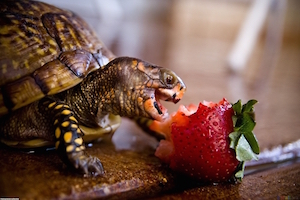The Yoga of Eating - Turning a Mealtime into a Meditation
For some, eating may come to be seen as something that gets in the way of yoga and meditation practice, but in fact the act of eating itself can be done in such a way that it is as much a meditation as sitting motionless in the lotus position. For those who find it hard to fit in enough sitting practice, the three or so meals a day provide the perfect opportunity to train the awareness, reconnect with the body and to realign oneself with an intention of loving-kindness.
In an age characterised by a bewildering mass of contradictory information about what we should and should not be eating, endeavouring to be more present as we eat might be our best chance of tuning into our body's wisdom and guidance about what is right for us, at this time, for our own particular body. Side benefits of this highly engaging practice include improved health and clearer awareness of the body's needs in general. So, leaving aside speculation about what foods you should be eating, here are 10 top tips to sharpen your intuition and balance your relationship with food through the practice of the Yoga of Eating.
1. Hungry for practice?
Often we either obey hunger immediately, by getting something to eat, or ignore it altogether (in the face of other more pressing demands on our attention). So we would do well to start our eating meditation with a few moments exploring the sensations of hunger with calmness and curiosity. By getting to know hunger a little better, we are less likely to feel the urgency to get rid of it by eating the first thing we can find.
In an age characterised by a bewildering mass of contradictory information about what we should and should not be eating, endeavouring to be more present as we eat might be our best chance of tuning into our body's wisdom and guidance about what is right for us, at this time, for our own particular body. Side benefits of this highly engaging practice include improved health and clearer awareness of the body's needs in general. So, leaving aside speculation about what foods you should be eating, here are 10 top tips to sharpen your intuition and balance your relationship with food through the practice of the Yoga of Eating.
1. Hungry for practice?
Often we either obey hunger immediately, by getting something to eat, or ignore it altogether (in the face of other more pressing demands on our attention). So we would do well to start our eating meditation with a few moments exploring the sensations of hunger with calmness and curiosity. By getting to know hunger a little better, we are less likely to feel the urgency to get rid of it by eating the first thing we can find.


Hunger indicates the presence of agni, the digestive fire, which is felt as that rumbling sensation in the solar plexus. Agni can be likened to a strong furnace that is able to consume any fuel that is fed to it. Food that is improperly digested leads to the depositing of ama (toxic residues) in the joints, tissues and organs. For this reason, it is important to distinguish between authentic hunger (accompanied by the sensation of agni) and what we might call stimulus hunger, which is more about being seduced by what we see (eye hunger), by what we can smell (nose hunger) or by what the mind is telling us it would be nice to eat (mind hunger).

2. Posture
Just as in sitting practice, the recommendation for an eating meditation is to maintain an upright posture with a straight back, either in a chair, in a cross-legged position or, for the real Indian roadside experience, in a squat. As well as reflecting an intention to remain alert and present, this upright position prevents the digestive organs from being cramped, which impairs their proper function. If the social situation allows, eating with the hands is an option, with each connection between the hand and the mouth creating a kind of mudra, a sacred gesture.
After the meal, a posture that aids digestion is vajrasana (sitting upright on the heels in a kneeling position). If you have over-indulged, there is what I call the emergency digestion posture – lying on the back with knees raised, feet flat on the floor and both hands resting on the belly, gently directing pranic energy to to the digestive organs.
Just as in sitting practice, the recommendation for an eating meditation is to maintain an upright posture with a straight back, either in a chair, in a cross-legged position or, for the real Indian roadside experience, in a squat. As well as reflecting an intention to remain alert and present, this upright position prevents the digestive organs from being cramped, which impairs their proper function. If the social situation allows, eating with the hands is an option, with each connection between the hand and the mouth creating a kind of mudra, a sacred gesture.
After the meal, a posture that aids digestion is vajrasana (sitting upright on the heels in a kneeling position). If you have over-indulged, there is what I call the emergency digestion posture – lying on the back with knees raised, feet flat on the floor and both hands resting on the belly, gently directing pranic energy to to the digestive organs.
3. Preparatory steps
Once sitting down with the food in front of you, take three deeper breaths to settle the body and mind, to bring you into the present moment and to reaffirm your intention to eat with focussed attention and enhanced awareness. Saying (or singing) a meal blessing or pausing to reflect on how fortunate you are to have enough food to eat when so many in the world do not is helpful in cultivating a sense of gratitude to set the tone for the rest of the meal.
4. Engaging the senses
Before taking food into the mouth, take some time to appreciate the food laid out before you with your eyes, taking in all the details of colour, texture and tone. Then bring the food up to your nose, breathing in and exploring the aromas of each item. As is said in Japan, “First eat with the eyes, then with the nose, and then with the mouth.”
5. Focussing the awareness
The focus of awareness can either be quite narrow, for example keeping the eyes closed and just concentrating on the different flavours and textures in the mouth, or more spacious, so that it includes the sounds, sights and smells of the food, as well as what is going on in the rest of the body as you eat. But however wide the focus, we should aspire not to divide or direct our focus away from the experience of eating by reading, watching TV or making plans. Unless you are eating on your own or are on a silent retreat, conversation is likely to present a significant challenge to your ability to be absorbed in the act of eating, so you may want to make some sort of a mutual agreement with your fellow eaters either to eat in silence or to focus conversation on the food.
As well as paying attention to what is happening within our mouth as we eat, we can notice the range of responses that occur in the body. It can be helpful to reflect on questions such as, “How is my body receiving this food?”, “Is my body actually enjoying this?”, “What is happening in my stomach as I swallow this food?” If it is a good food for you to be eating, you might notice a pleasant feeling in your heart centre, your body rejoicing as you swallow, a sense of your energy coming into balance, or your cells being deeply nourished. If it is not such a good food to be eating at this time, you may feel your body tensing slightly, or different parts of the body (such as the throat or stomach) contracting or swelling, either in a subtle or sometimes a quite noticeable way. There may be an increase in heart rate or an abrupt loss of appetite, or you may feel your energy suddenly dropping or becoming heavy. These cues are different for everybody and for different foods, but it is a language that can be learnt and understood.
6. Mouthful-by-mouthful awareness
The aim of eating meditation is to treat each mouthful as a unique experience, exploring it with renewed curiosity and fresh awareness... as if it were your last! It can be easy to sit down with your favourite food, but to be so distracted by thoughts, plans or what is going on around you that you forget to actually experience the pleasure of eating it... until it has all gone! Maintaining presence and awareness whilst eating, conversely, means noticing an array of unexpected flavours emerge from foods: subtle bursts of the six different flavours (sweet, sour, bitter, salty, pungent and astringent) being briefly released in an infinite variety of sequences and combinations, making each mouthful a veritable journey of taste sensation.
Once sitting down with the food in front of you, take three deeper breaths to settle the body and mind, to bring you into the present moment and to reaffirm your intention to eat with focussed attention and enhanced awareness. Saying (or singing) a meal blessing or pausing to reflect on how fortunate you are to have enough food to eat when so many in the world do not is helpful in cultivating a sense of gratitude to set the tone for the rest of the meal.
4. Engaging the senses
Before taking food into the mouth, take some time to appreciate the food laid out before you with your eyes, taking in all the details of colour, texture and tone. Then bring the food up to your nose, breathing in and exploring the aromas of each item. As is said in Japan, “First eat with the eyes, then with the nose, and then with the mouth.”
5. Focussing the awareness
The focus of awareness can either be quite narrow, for example keeping the eyes closed and just concentrating on the different flavours and textures in the mouth, or more spacious, so that it includes the sounds, sights and smells of the food, as well as what is going on in the rest of the body as you eat. But however wide the focus, we should aspire not to divide or direct our focus away from the experience of eating by reading, watching TV or making plans. Unless you are eating on your own or are on a silent retreat, conversation is likely to present a significant challenge to your ability to be absorbed in the act of eating, so you may want to make some sort of a mutual agreement with your fellow eaters either to eat in silence or to focus conversation on the food.
As well as paying attention to what is happening within our mouth as we eat, we can notice the range of responses that occur in the body. It can be helpful to reflect on questions such as, “How is my body receiving this food?”, “Is my body actually enjoying this?”, “What is happening in my stomach as I swallow this food?” If it is a good food for you to be eating, you might notice a pleasant feeling in your heart centre, your body rejoicing as you swallow, a sense of your energy coming into balance, or your cells being deeply nourished. If it is not such a good food to be eating at this time, you may feel your body tensing slightly, or different parts of the body (such as the throat or stomach) contracting or swelling, either in a subtle or sometimes a quite noticeable way. There may be an increase in heart rate or an abrupt loss of appetite, or you may feel your energy suddenly dropping or becoming heavy. These cues are different for everybody and for different foods, but it is a language that can be learnt and understood.
6. Mouthful-by-mouthful awareness
The aim of eating meditation is to treat each mouthful as a unique experience, exploring it with renewed curiosity and fresh awareness... as if it were your last! It can be easy to sit down with your favourite food, but to be so distracted by thoughts, plans or what is going on around you that you forget to actually experience the pleasure of eating it... until it has all gone! Maintaining presence and awareness whilst eating, conversely, means noticing an array of unexpected flavours emerge from foods: subtle bursts of the six different flavours (sweet, sour, bitter, salty, pungent and astringent) being briefly released in an infinite variety of sequences and combinations, making each mouthful a veritable journey of taste sensation.
7. Tools and techniques
If you are going for the complete eating meditation experience, putting down cutlery between mouthfuls rather than—as is so often the case—preparing the next mouthful as you chew the present one, is the only way to go. Closing the eyes whilst chewing aids deeper focus and absorption. In addition to this, from time to time you can try different mindfulness methods to bring you more fully into the moment, such as eating with your non-dominant hand, using chopsticks or taking mini breaks that allow you to reconnect with your relaxed breath and reset your intention to eat meditatively. Or you can try talking to your food, complimenting it on it's finer attributes (“Oh strawberry, you are so plump, sweet and juicy!”).
8. Slowing things down
Most healthy-eating systems emphasise the need to chew each mouthful thoroughly to a pulp before swallowing it. As Mahatma Gandhi said, “Chew your liquids and drink your solids!”, meaning that as well as food being totally mashed and mixed with saliva before being drunk down, even liquids should be swilled around the mouth and “chewed”. In addition to making the act of eating a more meditative one, this releases more flavours in each mouthful, facilitates the digestion and absorption of nutrients, massages the gums and reduces the likelihood of overeating. In yogic terms, eating this way facilitates the extraction of prana (lifeforce) from the food.


9. Eating with kindness
All too often, we can eat in ways that are compulsive, detached, frenzied or in which we are unconsciously trying to push away uncomfortable emotions. We may eat or drink in excessive quantities, or consume things that cause harm to our body. Even with apparently healthy foods, we sometimes force foods or supplements on ourselves in an attempt to to make ourselves healthy. Eating should be an act of loving kindness, a time when we nourish ourselves and our body with the right amount of the foods that our bodies need. Holding in our hearts this intention, rather than being slaves to the mind's desire for endless sensation and distraction, we can turn each meal into an opportunity to become more friendly and connected with our bodies.
All too often, we can eat in ways that are compulsive, detached, frenzied or in which we are unconsciously trying to push away uncomfortable emotions. We may eat or drink in excessive quantities, or consume things that cause harm to our body. Even with apparently healthy foods, we sometimes force foods or supplements on ourselves in an attempt to to make ourselves healthy. Eating should be an act of loving kindness, a time when we nourish ourselves and our body with the right amount of the foods that our bodies need. Holding in our hearts this intention, rather than being slaves to the mind's desire for endless sensation and distraction, we can turn each meal into an opportunity to become more friendly and connected with our bodies.


Sometimes, despite a lack of bodily hunger, we may crave foods (most likely sweet ones) in a misguided attempt to give us emotional comfort. In such cases, there may be another way to meet this need that does not involve eating, such as meditation, relaxation or a change in attitude towards our emotional experience characterised by greater acceptance and gentle holding. In any case, whenever we do eat it is wise to eat with presence and with an attitude of kindness to self, as this will better fill our heart's cup and minimise the need for comfort eating.
Another way to involve the heart is to consider all the beings—human and otherwise—which have made it possible for you to enjoy your meal: the cooks, farmers, warehouse packers, bees, worms, birds, the bacteria in the soil etc. This way, as Vietnamese zen master Thich Nhat Hahn reminds us, you will never be eating alone.
10. Ending the practice
No matter how healthy the food we have eaten, if an excessive quantity has been consumed the effect on our body will be harmful. On the other hand, eating too little can leave us feeling ungrounded, spaced out and with little stamina for practice. In Ayurveda, it is said that cupping the hands slightly and bringing them together in prayer position represents the size of the stomach and therefore the right amount of food to eat at each meal. But more important than any such mental concept is learning to pay attention to internal cues (the feeling of the stomach being adequately full) rather than external cues (finishing everything on the plate, eating as much as other people have eaten, or eating what you think is the right amount...). One very useful internal cue is what I call the “yogic burp”, a small and subtle burp (easily missed if you are not looking for it) that occurs when we have eaten an appropriate amount. In any case, the most reliable indicator of the right amount is that at the end of a meal you feel more energised than before you sat down to eat.
Another way to involve the heart is to consider all the beings—human and otherwise—which have made it possible for you to enjoy your meal: the cooks, farmers, warehouse packers, bees, worms, birds, the bacteria in the soil etc. This way, as Vietnamese zen master Thich Nhat Hahn reminds us, you will never be eating alone.
10. Ending the practice
No matter how healthy the food we have eaten, if an excessive quantity has been consumed the effect on our body will be harmful. On the other hand, eating too little can leave us feeling ungrounded, spaced out and with little stamina for practice. In Ayurveda, it is said that cupping the hands slightly and bringing them together in prayer position represents the size of the stomach and therefore the right amount of food to eat at each meal. But more important than any such mental concept is learning to pay attention to internal cues (the feeling of the stomach being adequately full) rather than external cues (finishing everything on the plate, eating as much as other people have eaten, or eating what you think is the right amount...). One very useful internal cue is what I call the “yogic burp”, a small and subtle burp (easily missed if you are not looking for it) that occurs when we have eaten an appropriate amount. In any case, the most reliable indicator of the right amount is that at the end of a meal you feel more energised than before you sat down to eat.